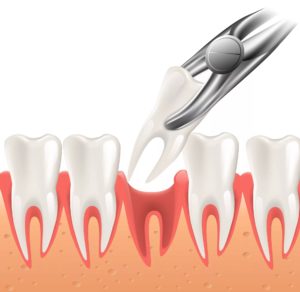Safe Tooth Extractions in Littleton, CO

Our dentists may determine that you need a tooth extraction for any number of reasons. Some teeth are extracted because they are severely decayed. Others may have advanced periodontal disease, or have broken in a way that cannot be repaired. Other teeth may need removal because they are poorly positioned in the mouth (such as impacted teeth), or preparation for orthodontic treatment.
The removal of a single tooth can lead to problems related to your chewing ability, problems with your jaw joint, and shifting teeth, which can have a major impact on your dental health.
To avoid these complications, in most cases, our dentists will discuss alternatives to extractions as well replacement of the extracted tooth.
Reasons You May Need A Tooth Extraction
There are numerous situations in which a simple extraction is needed. Extractions are typically performed because of an active problem such as pain, swelling, decay, infection, as a preventative measure to avoid serious problems in the future, or to prepare your for another cosmetic or restorative procedure.
Common reasons for tooth extractions include:
- Advanced periodontal disease that has loosened the roots of your tooth
- Extra teeth or baby teeth that impede adult teeth
- Preparing a patient for orthodontic treatment
- Removing a fractured or malformed tooth
- Severe tooth decay which cannot be fixed with root canal therapy
- Removal of Wisdom Teeth
The Extraction Process
At the time of extraction, the doctor will need to numb your tooth, jawbone, and gums that surround the area with a local anesthetic.
During the extraction process, you will feel a lot of pressure. This is from the process of firmly rocking the tooth to widen the socket for removal.
You feel the pressure without pain as the anesthetic has numbed the nerves stopping the transference of pain, yet the nerves that transmit pressure are not profoundly affected.
If you do feel pain at any time during the extraction please let us know right away.
How A Tooth Is Extracted
Although we often hope to avoid the extraction of a tooth, sometimes it is necessary if the tooth cannot be saved by a root canal or other dental procedure.
Extractions are usually performed under local anesthesia. For those with high anxiety or prefer to be sedated for this type of procedure, we also offer sedation dentistry.
Once the tooth has been pulled, a blood clot will form in the socket. The dentist will may place a few stitches to close the gums over the extraction site. The dentist will pack a gauze pad into the socket and have you bite down on it. This will help stop the bleeding and help the clot form. It’s important to let the clot heal and form properly. If the blood clot does not form properly, you can run the risk of a painful condition called dry socket.
Tooth Sectioning
Some teeth require sectioning. This is a very common procedure done when a tooth is so firmly anchored in its socket or the root is curved and the socket can’t expand enough to remove it. The doctor simply cuts the tooth into sections then removes each section one at a time.
Home Care After A Tooth Extraction
After tooth extraction, a blood clot needs to form to stop the bleeding and begin the healing process. Bite on a gauze pad for 30-45 minutes immediately after the appointment. If the bleeding or oozing persists, place another gauze pad and bite firmly for another 30 minutes. You may have to do this several times to staunch the flow of blood.
After the blood clot forms, it is important to not disturb or dislodge the clot. Do not rinse vigorously, suck on straws, smoke, drink alcohol or brush teeth next to the extraction site for 72 hours. These activities may dislodge or dissolve the clot and hinder the healing process. Limit vigorous exercise for the next 24 hours, as this increases blood pressure and may cause more bleeding from the extraction site.
After the tooth is extracted you may feel some pain and experience some swelling. An ice pack or an unopened bag of frozen peas or corn applied to the area will keep swelling to a minimum. Take pain medications as prescribed. The swelling usually subsides after 48 hours.
Use pain medication as directed. Call our office if the medication doesn’t seem to be working. If antibiotics are prescribed, continue to take them for the indicated length of time even if signs and symptoms of infection are gone. Drink lots of fluids and eat nutritious, soft food on the day of the extraction. You can eat normally as soon as you are comfortable.
It is important to resume your normal dental routine after 24 hours. This should include brushing and flossing your teeth at least once a day. This will speed healing and help keep your mouth fresh and clean.
After a few days, you should feel fine and can resume your normal activities. If you have heavy bleeding, severe pain, continued swelling for 2-3 days, or a reaction to the medication, call our office immediately.
